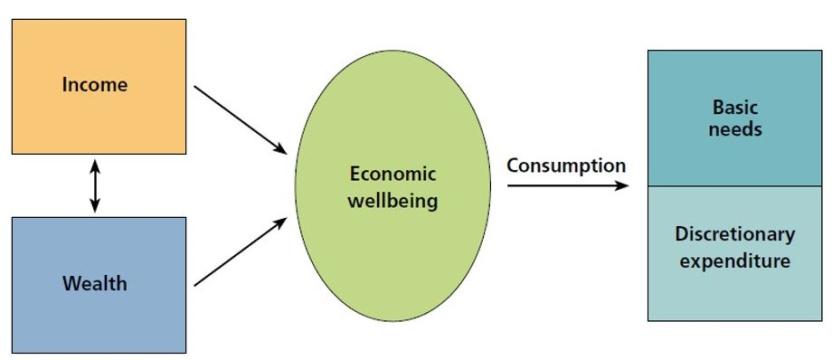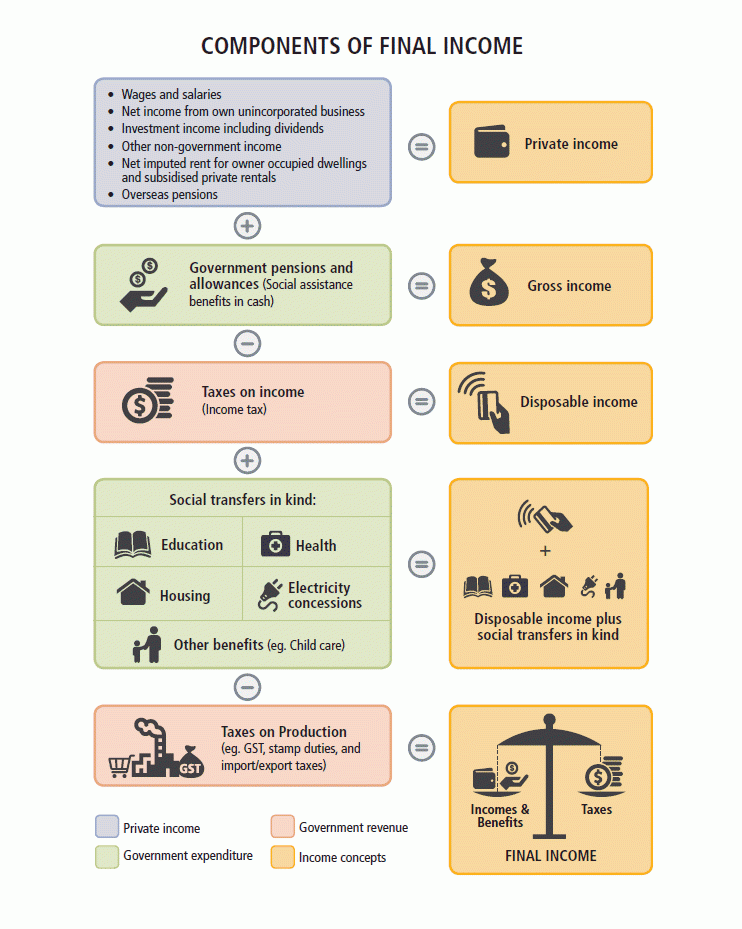| Table 1a – Household income economic well-being indicators(a)(b), Australia, 2009–10 to 2019–20 | Year | Change | |||||
|---|---|---|---|---|---|---|---|
| Economic Indicators – Income | 2009–10 to 2019–20 | 2017–18 to 2019–20 | |||||
| 2009–10 | 2017–18 | 2019–20 | Difference | % | Difference | % | |
| Gini coefficient for equivalised disposable household income(c)(d) | 0.329 | 0.328 | 0.324 | -0.005 | -1.5 | -0.004 | -1.2 |
| Gini coefficient for gross household income(d) | 0.428 | 0.439 | 0.436 | 0.008 | 1.9 | -0.003 | -0.7 |
| Mean weekly equivalised disposable household income(c) | $1,034 | $1,094 | $1,124 | $90(e) | 8.7 | $30 | 2.7 |
| Mean weekly gross household income | $2,058 | $2,310 | $2,329 | $271(e) | 13.2 | $19 | 0.8 |
| Median weekly equivalised disposable household income(c) | $872 | $926 | $959 | $87(e) | 10.0 | $33(e) | 3.6 |
| Median weekly gross household income | $1,610 | $1,753 | $1,786 | $176(e) | 10.9 | $33 | 1.9 |
- In 2019–20 dollars, adjusted using changes in the Consumer Price Index
- Due to the change in collection methodology, estimates may not be directly comparable to previous cycles. For more information please see the Household Income and Wealth, Australia - Methodology, 2019–20 financial year
- Household net worth is the value of all the assets owned by a household less the value of all its liabilities
- The Gini coefficient is the internationally accepted summary measure of inequality. Gini coefficient values range between 0 and 1. Values closer to 0 represent higher equality and values closer to 1 represent higher inequality
- The difference between periods is statistically significant
| Table 1b – Household wealth economic well-being indicators(a)(b), Australia, 2009–10 to 2019–20 | Year | Change | |||||
|---|---|---|---|---|---|---|---|
| Economic Indicators – Wealth | 2009–10 to 2019–20 | 2017–18 to 2019–20 | |||||
| 2009–10 | 2017–18 | 2019–20 | Difference | % | Difference | % | |
| Gini coefficient for household net worth(c)(d) | 0.602 | 0.621 | 0.611 | 0.009 | 1.5 | -0.010 | -1.6 |
| Mean household net worth(c) | $878,200 | $1,053,200 | $1,042,000 | $163,800(e) | 18.7 | -$11,200 | -1.1 |
| Median household net worth(c) | $519,300 | $576,000 | $579,200 | $59,900(e) | 11.5 | $3,200 | 0.6 |
| Mean total financial assets(f) | $312,800 | $440,600 | $445,000 | $132,200(e) | 42.3 | $4,400 | 1.0 |
| Mean total non-financial assets(g) | $711,700 | $802,300 | $798,000 | $86,300(e) | 12.1 | -$4,300 | -0.5 |
| Mean total liabilities | $146,200 | $189,500 | $203,800 | $57,600(e) | 39.4 | $14,300(e) | 7.5 |
| Proportions of households with debt | 71.9 | 72.8 | 74.6 | 2.7pts(e) | .. | 1.8pts(e) | .. |
| Proportions of households with debt 3 or more times income | 24.2 | 28.4 | 30.3 | 6.1pts(e) | .. | 1.9pts(e) | .. |
.. not applicable
- In 2019–20 dollars, adjusted using changes in the Consumer Price Index
- Due to the change in collection methodology, estimates may not be directly comparable to previous cycles. For more information please see the Household Income and Wealth, Australia - Methodology, 2019–20 financial year
- Household net worth is the value of all the assets owned by a household less the value of all its liabilities
- The Gini coefficient is the internationally accepted summary measure of inequality. Gini coefficient values range between 0 and 1. Values closer to 0 represent higher equality and values closer to 1 represent higher inequality
- The difference between periods is statistically significant
- Includes, for example, accounts held with financial institutions (including offset accounts), ownership of an incorporated business, shares, debentures and bonds, trusts, superannuation funds, and loans to other persons
- Includes, for example, residential and non-residential property, household contents and vehicles
In 2019–20, compared to 2017–18, average equivalised disposable household income and average net worth for Australian households, saw no statistically different changes. In contrast, average total liabilities for households and the proportion of households servicing total debt three or more times their annualised disposable income had statistically different increases.
Over the decade to 2019–20, there were statistically different changes in equivalised disposable household income, average net worth, average total liabilities and the proportion of households servicing total debt three or more times their annualised disposable income.
- In 2019–20, the average equivalised disposable household income was $1,124 per week. This was not statistically significantly different from the average in 2017–18 ($1,094 per week), but was statistically significantly different compared to a decade before ($1,034 per week in 2009–10).
- The average net worth for all Australian households in 2019–20 was $1.04 million. This was not statistically significantly different from $1.05 million in 2017–18, but an 19% increase compared with 2009–10 ($878,200) was statistically significant.
- The average total liabilities for households saw a statistically significant increase from $189,500 in 2017–18 to $203,800 in 2019–20, and a 39% increase compared to a decade before ($146,200 in 2009–10).
- Three in four (75%) households had debt in 2019–20. Of these households, 30% were servicing a total debt three or more times their annualised disposable income, which was a statistically significant increase from 2009-10 (24%) and 2017-18 (28%).
- Survey of Income and Housing data was collected in labelled years
- In 2019–20 dollars, adjusted using changes in the Consumer Price Index
- Due to the change in collection methodology, estimates may not be directly comparable to previous cycles. For more information please see the Household Income and Wealth, Australia - Methodology, 2019–20 financial year
- In 2007–08 there was a change in income standards, see the Household Income and Wealth, Australia - Methodology, 2019–20 financial year for more information
- Equivalised disposable household income estimates are adjusted by equivalence factors to standardise them for variations in household size and composition, while taking into account the economies of scale that arise from the sharing of dwellings
Source(s): ABS Survey of Income and Housing, various years
- In 2019–20 dollars, adjusted using changes in the Consumer Price Index
- Due to the change in collection methodology, estimates may not be directly comparable to previous cycles. For more information please see the Household Income and Wealth, Australia - Methodology, 2019–20 financial year
- Comprehensive wealth data was not collected in 2007–08
Source (s): ABS Survey of Income and Housing, various years

